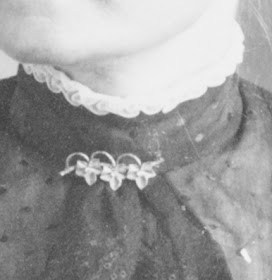My test, of course, is entirely unrealistic for the normal genealogist who likely does not want to spend a good portion of their annual income on cameras, lenses, scanners and other electronic devices.
For a camera, I have migrated to a Canon 5D Mark II with a Canon EF 500mm 1:1.8 lens. For a scanner, I am using a Conoscan 8800F. Both of these products have been replaced by newer models. Canon now has a 5D Mark III and a Canoscan 9000F (soon to be updated). The camera has a 36.0 mm x 24.0 mm (35 mm Full-frame) sensor and is rated at 22 megapixels.
The scanner is a CCD device with a stated Optical: 4800 x 9600 dpi and an Interpolated: 19,200 x 19,200 dpi.
I have chosen the above image for the scan. It is a photographic print of my Great-grandmother, Margaret Godfrey Jarvis Overson and measures 3 5/8 inches x 2 5/8 inches. It is a high-contrast black and white image from a glass-plate negative.
Here is the scan from the Canoscan 8800 at 300 dpi and then second at 600 dpi. Just for fun, I scanned a third copy at 1200 dpi. See labels. The photo was scanned using VueScan software running on an Apple iMac computer at 16 bits grayscale. OK, so with that resolution, the file sizes became an issue, especially with uploading the files to a blog post. Keep in mind the no matter what my file size or resolution, you are viewing the photos on some kind of monitor or screen and so what you see is screen resolution. That is one reason for magnifying the images, to give a screen view of the amount of detail in actual file. All of the files were converted to .jpeg files so they could be viewed over the internet. The 300 dpi file is 3.1 MB, the 600 dpi file is 12.4 MB and the 1200 dpi scan is 49.4 MB.
OK, guess what? They look almost identical. However, if you click on the images, you will see that they are saved at different physical sizes. So there must be something going on here.
 |
| Margaret Godfrey Jarvis Overson Scan at 300 dpi |
 |
| Margaret Godfrey Jarvis Overson Scan at 600 dpi |
 |
| Margaret Godfrey Jarvis Overson Scan at 1200 dpi |
Here is the same photo, using the Canon 5D Mark II with the 50 mm lens. I illuminated the photo with two LED 60 watt lights and took the photo about eighteen inches from the lens using Autofocus.
Ok, so this image does not have the same contrast etc. So here it is again with some adjustments:
I could work on the image some more, but here I am talking about resolution and detail so on to the next level.
 |
| Margaret Godfrey Jarvis Overson Image from Canon Camera Adjusted |
Now let's look at the detail of the image: Here is the same section of each image at 200% in Adobe Photoshop:
 |
| Margaret Godfrey Jarvis Overson Canon Camera at 200% |
 |
| Margaret Godfrey Jarvis Overson Canon Camera Adjusted 200% |
Now, look at each image. Do you see any dramatic differences? I don't particularly, setting aside any exposure or contrast issues.
So why would I choose to use my camera over the scanner? It looks to me that the quality is almost identical, but I can take dozens of photos in the same time I do a few scans. The main difference in the higher quality scans on the scanner is file size and the ultimate size at which the image could be printed with the same quality.
More about this later, but here is the first pass of what you might want to know about the current quality of both scanners and high-end digital cameras.
So why would I choose to use my camera over the scanner? It looks to me that the quality is almost identical, but I can take dozens of photos in the same time I do a few scans. The main difference in the higher quality scans on the scanner is file size and the ultimate size at which the image could be printed with the same quality.
More about this later, but here is the first pass of what you might want to know about the current quality of both scanners and high-end digital cameras.





I think what you're talking about when using a camera, is a high end camera, maybe tripod mounted, taking a picture of a well lighted document on a flat table?
ReplyDeleteBut what about the case of photographing a document in a not-so-well lighted library using a cellphone or cheaper point and shoot camera? Is that useful, or would I need handheld scanner?
Bob Kirk